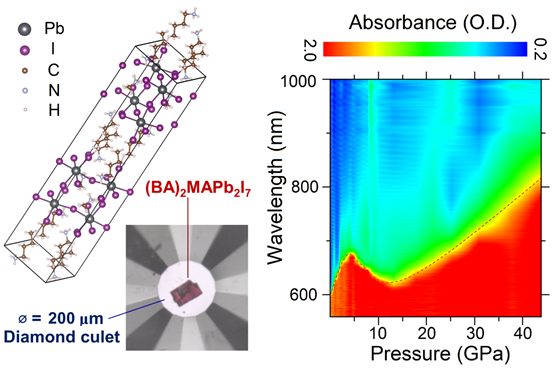First high pressure study on 2D hybrid perovskites - Dr. Gang Liu
OCTOBER 19, 2017
New work led by HPSTAR researcher, Dr. Gang Liu experimentally convinced a first example of pressure-improved 2D hybrid perovskites and proposed that pressure treatments might offer a useful route to yield near-ideal single junction performance in the 2D hybrid perovskites. The discoveries are published by ACS Energy Letters.
The power conversion efficiency of hybrid perovskites-based solar cell has been improved over 22%, whilst poor stability impedes its applications. This pushed researchers to investigate compositional and morphological variants. The recent developed two-dimensional layered perovskites show improved structure stability. However, the quantum confinement widens the band gap, which decreases the power conversion efficiency for low-cost, single junction devices.
The team including collaborators from HPSATR, Geophysical Laboratory of Carnegie Institution of Washington, Argonne National Laboratory, and Northwestern University gave a first in situ high pressure structural and optical study on 2D layered hybrid materials. They observed two regimes of compression, layer-to layer and interlayer in the layered perovskites.
“The two regimes of compression behavior correspond to the softer organic sub-lattice and the less compressible inorganic sub-lattice”, Dr. Liu explained. “And it’s never found in 3D hybrid perovskites”.
The research team also discovered two-step band-gap-redshift below 4 gigapascals and after 13 gigapascals from optical measurements.
“As both the two compressions will cause bandgap narrowing, the two-step bandgap shift can be attributed to the layer to layer and interlayer compressions, respectively”, Dr. Liu further explained.
“We expect these results can be expanded into other 2D hybrid perovskites and suggest that pressure/strain processing could offer a new route to improved materials-by-design in applications”, added Dr. Liu.

Caption
Ambient structure of 2D hybrid perovskites and their pressure-driven bandgap re-redshift behavior.
对于有机-无机杂化钙钛矿光伏材料而言,目前最重要的课题之一是如何同时实现高水平的光电转换效率和优异的环境稳定性。二维层状的杂化钙钛矿显现出较好的环境稳定性,但基于其的器件的光电转换效率仍较传统的杂化钙钛矿晶体有着较大的差距,其中一个关键的原因是其光学带隙较大,继而导致吸光性能下降。来自北京高压科学研究中心的刘罡博士研究小组利用静压力有效调控了二维杂化钙钛矿的晶体及电子结构,发现了压缩过程中的光学带隙的红移与再次红移现象。与施加压力前的样品相比,完全卸压后的样品更在保持其优良环境稳定性的基础上实现了光致发光增强和光学带隙减小等多个有利于吸光层器件应用的特性。
